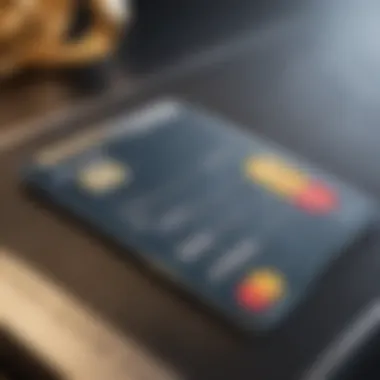Exploring Charge Card Systems: Functions and Insights


Intro
The world of payment systems has seen its fair share of innovations, but few offer the unique features and intricacies that charge card systems do. To fully grasp their significance in today’s financial landscape, it’s essential to delve into the nuts and bolts of how they work, their advantages, and the potential disadvantages that come with them.
Charge cards serve a specific purpose within the much larger realm of credit instruments, sitting at an interesting juncture between credit and debit cards. Unlike credit cards, charge cards must be paid in full each month, which fundamentally shapes the user experience and the financial behavior of those who opt for them. While they might not be the most mainstream choice, charge cards have a staunch following among consumers who appreciate the perks they offer, especially with regards to travel rewards and spending flexibility.
In this analysis, you’ll uncover the mechanics behind charge cards. The punchline here is not just knowing what charge cards are, but also understanding the historical context that led to their development and how they fit into the broader picture of modern finance. We’ll also draw parallels with credit cards and debit cards, so that you can make informed financial choices as a consumer, investor, or financial advisor. The nuances of these systems will be presented in an accessible manner, ensuring that whether you’re a seasoned investor or just someone starting their financial journey, you can walk away with a clearer picture of what charge cards bring to the table.
So, without further ado, let’s dive deeper into the investment terminology and concepts that underpin charge cards.
Preface to Charge Card Systems
Charge card systems, while they might not always grab headlines like their credit and debit counterparts, play a crucial role in the personal finance landscape. Understanding these systems is essential, especially for investors and financial advisors looking to optimize financial strategies for themselves or their clients.
When we dive into charge cards, we're not just examining another financial tool. We are delving into a mechanism that reflects evolving consumer behavior and changing economic conditions. Charge cards are deeply intertwined with concepts of creditworthiness and buying power, providing valuable insights into consumer confidence and spending habits.
Defining Charge Cards
Charge cards are a type of payment card that requires the cardholder to pay off the full balance each month. Unlike credit cards, which allow users to carry a balance, charge cards promote disciplined spending: you can charge purchases, but you have to settle up before the next billing cycle. This pay-in-full requirement guarantees no interest accrues, encouraging users to manage their cash flow with a tight grip.
Some renowned issuers of charge cards, such as American Express and Diners Club, have crafted unique offerings. They may include a host of benefits, including travel perks, access to exclusive events, and even concierge services that can enhance a cardholder's lifestyle.
Evolution of Charge Card Systems
Historically speaking, charge cards have come a long way since their inception in the mid-20th century. They originally emerged as a response to the growing need for a convenient payment mechanism—a way to forgo carrying cumbersome cash.
- 1930s - 1940s: The first charge cards were introduced, mainly aimed at affluent consumers. The Diners Club card, for instance, was launched in 1950, catering to a crowd who valued exclusive dining experiences.
- 1970s - 1980s: As consumer confidence grew and disposable incomes increased, so did the adoption of charge cards. Credit card companies recognized the potential market and began offering similar products.
- 1990s - 2000s: Technology reshaped charge cards, integrating magnetic stripes and later, chip technology. The rise of the internet demanded innovation, prompting additional security features.
- 2010s to Present: With mobile payments on the rise and the concept of digital currencies gaining traction, charge card systems are adapting yet again. Providers now offer application-based services that grant instant access and real-time tracking of spending.
In tracing the evolution of charge card systems, we witness not just a product of finance, but also an adaptation to societal shifts and technological advancements. The sophisticated features and targeted benefits of contemporary charge cards reflect an understanding of a changing marketplace, granting flexibility and security to users.
Understanding the past of charge cards helps us navigate the complexities of today's financial ecosystem. The historical context offers insights that are not merely academic but practical for anyone involved in personal finance.
Comparing Charge Cards with Other Payment Methods
Understanding how charge cards fit within the broader landscape of payment methods is crucial for comprehending their unique advantages and disadvantages. Charge cards serve as an alternative to other financial instruments, particularly credit and debit cards. The discussion here isn’t just an academic exercise; it’s about knowing how to leverage these tools effectively for personal finances and business transactions.
Charge Cards vs. Credit Cards
Charge cards and credit cards both allow for purchasing goods and services without the immediate need for cash. However, the ways they operate and the implications for users vary significantly.
- Payment Structure: Charge cards require full payment of the balance by the end of each billing cycle. That means if you spend $1,200, you need to clear the whole amount before the due date to avoid penalties. Credit cards, on the other hand, offer a revolving credit limit, allowing users to carry a balance but incurring interest on any unpaid amount.
- Credit Limits: Charge cards generally do not have a preset spending limit, giving users greater flexibility. This can be advantageous for those who might need to make larger purchases. Credit cards usually impose a limit based on creditworthiness, which can restrict spending for some users.
- Rewards and Perks: Many charge card companies offer extensive rewards programs and travel benefits, often more generous than what credit cards provide. For high spenders, this could mean substantial perks such as cash back or airline miles, which makes charge cards appealing.
- Fees and Penalties: While both types involve fees, charge cards typically have an annual fee, but they avoid interest charges, making them sometimes more straightforward unless one fails to pay in full. With credit cards, late payments can lead to high-interest fees besides the standard annual fees.
"Charge cards can be a double-edged sword; they allow greater freedom but come with high expectations for repayment."
Charge Cards vs. Debit Cards
The interplay between charge cards and debit cards introduces a different paradigm in terms of financial management. The primary distinction is how funds are accessed and the implications for budgeting.
- Funding Sources: Debit cards draw directly from the user's bank account, which helps to avoid debt accumulation, as purchases can only be made with available funds. Charge cards, conversely, effectively extend credit, creating an obligation to pay in full each month.
- Spending Control: Debit cards inherently promote responsible spending since they limit usage to actual savings. Charge cards can lead to overspending if users don’t keep careful track of their expenses. For some, this could create a false sense of financial freedom that can backfire.
- Secured Transactions: Debit cards might offer less protection against fraud compared to charge cards. The user’s liability for fraudulent charges on debit accounts can be stricter than that for charge cards, where protections are generally more robust.
- Building Credit: Charge cards help users build credit profiles, provided they maintain consistent payment histories, which is not the case with debit cards. This aspect makes charge cards appealing for strategizing personal finance and credit building.
Mechanics of Charge Card Systems
Understanding the mechanics of charge card systems is crucial for both consumers and businesses alike. Amid today’s financial complexities, these systems serve unique purposes, offering particular benefits and considerations. By unraveling how charge cards function, one can appreciate their role in payment processing, consumer behavior, and financial planning.
How Charge Cards Work
Charge cards operate on a straightforward principle: consumers are given a predetermined credit limit, which they must repay in full at the end of each billing cycle. This requirement sets charge cards apart from credit cards, where borrowers can carry balances over multiple months. The first thing one notices when getting a charge card, let's say the American Express Green Card, is the emphasis on responsibility. If you overspend, it doesn’t just mean facing hefty interest rates. It means you have to come up with the entire amount, and if not, the consequences can be severe.
Using a charge card is often as simple as swiping at a point-of-sale terminal or entering the card number online. It works with a network of merchants who accept these cards, ensuring smooth transactions. Additionally, many charge cards provide fraud protection, which might be a sigh of relief for users worried about theft or unauthorized use. The catch, however, lies in the billing: timely payments are not just preferred; they are mandatory.


One must also consider rewards and perks that come with these cards. Many charge cards link to loyalty programs, allowing users to earn points or cash back for their spending. Those rewards can be significant, often leading to free travel, exclusive access to events, or other benefits. Therefore, while the responsibility associated with charge cards can sound intimidating, the potential premium features they offer can make the experience rewarding.
Understanding Billing Cycles
Billing cycles for charge cards operate on a monthly basis, with fixed due dates for the total account balance. By comprehending how these cycles stack up, individuals can better strategize their expenses and payments. Every billing cycle begins and ends on specific dates; think of these as checkpoints to consolidate your finances.
Here’s the basic cycle:
- Start Date: The day your cycle opens; any purchases made after this point count towards the next bill.
- Monthly Usage: Charges accumulate over the month, and it's vital here to monitor spending to avoid that dreaded surprise at the end.
- Statement Date: The day your billing statement is generated, which summarizes all transactions made during the cycle.
- Due Date: The deadline by when the cardholder’s total balance needs to be cleared to avoid late fees or penalties.
It’s worth noting that missing a payment is not just a minor hassle; it can affect one’s credit score significantly showing that even though the billing process is fairly easy to understand, mismanagement can lead to serious repercussions.
Many users adopt a systematic approach to track their spending habits, ensuring they know exactly how much their spending aligns with their income. Using budgeting tools and apps can smooth this process, allowing for a clear picture of financial status. Overall, understanding billing cycles is not merely a suggestion—it is a necessity for anyone looking to use charge cards effectively.
Advantages of Using Charge Cards
When assessing the financial landscape, understanding the advantages of using charge cards provides valuable insights for individuals and businesses alike. Charge cards offer unique benefits that can enhance purchasing power and rewards, making them a compelling option in the broader realm of payment methods. In this section, we will dive into the specific elements that make charge cards a favorable choice.
Enhanced Purchasing Power
Charge cards are often associated with increased purchasing power, especially for those with good credit histories. Unlike credit cards, which come with predetermined credit limits, charge cards don't typically impose such restrictions. This flexibility enables users to make larger purchases without immediate concerns of exceeding spending caps. For instance, a business professional might utilize a charge card to book international travel or acquire high-end equipment necessary for their operations, all while enjoying peace of mind about available funds.
Moreover, many charge cards provide the ability to finance purchases over time. While full payment is generally expected each billing cycle, some providers may offer grace periods or flexible payment options for larger expenses. This can be particularly beneficial for cash flow management in businesses that experience fluctuating revenues.
This increased purchasing power carries an inherent responsibility, too. Users must manage their spending carefully to avoid falling into a cycle of debt or overspending. Keeping track of expenses and having a solid financial plan can help mitigate risks associated with this powerful financial tool.
Rewards and Benefits
A significant allure of charge cards is the rewards and benefits associated with their usage. Many charge cards come with attractive rewards programs that can enhance the overall value provided to cardholders. Whether it's cash back, travel points, or discounts on future purchases, these incentives can add up, turning regular spending into future opportunities.
For example, a frequent traveler may choose a charge card that offers airline miles. With each purchase, they accumulate miles that can be redeemed for flights or upgrades, effectively turning everyday spending into valuable travel experiences. Additionally, various charge card programs may offer exclusive access to special events, concierge services, or premium experiences that elevate their cardholders' lifestyle.
Often, these charges cards also provide insurance benefits, such as travel accident insurance or extended warranties on purchases. Such added protections can serve as a safety net, allowing users to feel secure about their purchases while enjoying the additional perks.
A well-chosen charge card can turn ordinary expenses into extraordinary rewards, thereby maximizing the financial benefit of daily transactions.
The combination of enhanced purchasing power and rewards encourages thoughtful spending habits. Investors and financial advisors may find these features compelling, as they often translate into cost-effective strategies that yield both immediate and long-term benefits.
Disadvantages and Risks of Charge Cards
While charge cards can be useful tools for managing expenses and earning rewards, they come with their own set of challenges that can impact users financially. Understanding the disadvantages and risks associated with charge cards is crucial for anyone considering their use. This section unravels these potential pitfalls, providing insight into some critical elements such as overspending and incurred fees, allowing for informed decision-making.
Potential for Overspending
One of the main risks tied to charge cards lies in the potential for overspending. Unlike credit cards, which typically allow a revolving balance, charge cards generally require the entire balance to be paid off each month. With an attractive spending limit and the flexibility of making large purchases, it's easy for cardholders to lose track of their monthly expenses.
Take, for example, a small business owner who uses a charge card to cover expenses during a busy season. The lure of quick access to funds can drive overspending on supplies, leading to a situation where the total bill comes as a shock when payment is due. It’s essential to maintain an organized budget, as the absence of pre-set spending limits can lead to some serious deficits when funds are ultimately needed elsewhere.
Fees and Penalties
Charge cards are not devoid of fees, which can be a nasty surprise for unwary users. Annual fees, late payment penalties, and foreign transaction charges can quickly add up. Unlike some credit cards that offer a grace period, charge card holders are often slapped with hefty penalties if payments are missed or delayed.
The annual fees can be particularly steep for premium cards that come with enhanced benefits and rewards. However, if the cardholder doesn't utilize those perks effectively, they might find themselves stuck paying a sizable fee without gaining corresponding value in return.
For instance, a person traveling abroad and using a charge card incurs 3% in foreign transaction fees on every purchase. If their expenses reach $2,000, this can easily translate into an extra $60 in fees added onto the bill, not to mention any possible late fees if one goes over their budget and struggles to meet their monthly payment.
In summary, while charge cards can enhance financial flexibility and reward opportunities, the disadvantages in overspending potential and associated fees warrant close attention. Careful budgeting, diligent record-keeping, and a keen understanding of card terms can significantly mitigate these risks.
"If you don’t watch your spending, it’ll slip through your fingers faster than sand."
Understanding these concerns is vital to ensure that the advantages of charge cards do not overshadow their potential risks. By taking a balanced approach, you can navigate the landscape of charge cards more effectively.


The Role of Charge Cards in Personal Finance
Understanding the role of charge cards in personal finance goes beyond the surface level of simply swiping a card to make purchases. Charge cards carry unique features and responsibilities that can significantly influence an individual's financial landscape. These cards can enhance purchasing power, offer valuable rewards, and help in the process of building a solid credit history, but they also demand careful consideration regarding spending habits and financial planning.
Building Credit History
Charge cards are often considered an important tool in the arsenal of anyone looking to build or improve their credit history. Unlike some credit cards, charge cards usually require the balance to be paid in full each month. This can set a solid foundation, as it encourages healthy financial behaviors, such as timely payments, which are critical factors in credit scoring.
When a user consistently makes on-time payments, it can lead to a positive impact on their credit score. Moreover, many charge cards report to the major credit bureaus, which means that responsible usage will reflect well on one's credit report.
However, it’s essential to bear in mind that failing to pay off the balance in full can result in steep penalties or a detrimental effect on the credit score. Therefore, users should be vigilant and disciplined, ensuring they only make purchases they can afford to pay off each month. It's sort of like walking a tightrope, where balance and awareness are critical to avoid falling into debt.
Budgeting with Charge Cards
Using charge cards can also facilitate budgeting, provided that they are utilized wisely. By tracking spending habits through charge card statements, individuals can identify patterns in their purchasing behavior. These insights can direct better budgeting efforts and inform financial planning.
For instance, if someone notices they're consistently overspending on takeout, they could make a conscious effort to cut back in that area. The detailed records that come with charge cards might make it easier to allocate funds appropriately across various categories like groceries, entertainment, and savings.
Here are some actionable tips for effectively budgeting with charge cards:
- Set a Monthly Limit: Determine a threshold for how much you're willing to spend via charge card each month to avoid impulse purchases.
- Review Statements: Regularly review your statements to track where your money is going and adjust accordingly.
- Use Alerts: Many charge cards allow users to set up spending alerts. Using these tools can provide real-time feedback on spending habits, fostering accountability.
In summary, charge cards can play a pivotal role in personal finance by not only aiding in building a robust credit history but also enhancing budgeting practices. Responsible use of charge cards can yield long-term benefits, but it’s a double-edged sword that requires careful management and strategic planning. As always, making informed choices will significantly contribute to financial health.
Consumer Protections in Charge Card Systems
The landscape of charge card systems is not just about the cards themselves; it encompasses the myriad of consumer protections that give users a safety net in a fast-paced financial world. Understanding these protections is paramount for anyone engaged with charge cards, be it individuals, small business owners, or financial professionals. The importance lies in not only safeguarding personal finances but also fostering trust in financial institutions.
Understanding Legal Protections
Legal protections surrounding charge cards come from both federal and state laws. In the United States, two major statutes play a pivotal role: the Fair Credit Billing Act and the Truth in Lending Act. These laws ensure that consumers have rights when they engage in transactions involving charge cards.
Under the Fair Credit Billing Act, users can dispute charges that are erroneous or involve fraud. Consumers must act promptly. For instance, if someone notices a charge for a purchase they did not make, they have a limited time frame—typically 60 days—to notify the card issuer. Upon receipt of the consumer's inquiry, the issuer must investigate and respond, preventing the consumer from being held liable for disputed amounts during the process.
Moreover, the Truth in Lending Act mandates transparency from issuers regarding terms and conditions. This includes presenting interest rates, potential fees, and annual percentage rates (APRs) in a straightforward manner, which allows cardholders to make informed decisions before they swipe their cards. Importantly, having such legal protections helps to build a foundation of trust between consumers and financial institutions. When people feel protected, they are more likely to utilize charge cards as a reliable source of financial management.
Dispute Resolution Processes
Navigating the dispute resolution process with charge cards may seem daunting at first, yet it’s a systematic approach designed to address concerns between consumers and card issuers. Once a consumer submits a dispute, it often follows a set path: initial communication, investigation, and resolution.
- Initial Communication: This is where it begins. Consumers should reach out directly to their card issuer, either through a phone call or by submitting a written complaint. It’s crucial to provide as much detail as possible about the disputed charge, including dates, amounts, and any relevant documentation.
- Investigation: After the issuer receives the complaint, they typically have 30 days to investigate. During this period, the issuer may try to contact merchants involved to assess the validity of the claim. They also review transaction histories and any records of communication between the consumer and the merchant.
- Resolution: Once the investigation finishes, the issuer informs the consumer of the outcome. If the dispute is resolved in the consumer's favor, they will not have to pay the charged amount. However, if the investigation concludes that the charge is valid, the consumer will be liable for the payment. In the event of dissatisfaction with the outcome, further steps can be taken, including filing complaints with consumer protection agencies or seeking legal advice.
The resolution process aims to be fair and transparent, allowing consumers to voice concerns while enabling financial institutions to maintain their standards of service and protect integrity.
"Consumer protections act as a shield, creating a more balanced relationship between users and issuers."
Charge Cards in Business Transactions
The integration of charge cards into business transactions has become a significant topic in the evolving landscape of corporate finance. The role that charge cards play in helping business owners manage spending and maintain financial agility cannot be understated. Charge cards offer a unique blend of convenience and flexibility, making them a preferred option for many enterprises. As technology advances and consumer habits shift, understanding how charge cards can be leveraged effectively is critical for capitalizing on their benefits while navigating potential pitfalls.
Benefits for Business Owners
Charge cards provide numerous advantages that can bolster a business’s financial management and operational efficiency:
- Cash Flow Management: One of the most appealing aspects of charge cards is their impact on cash flow. They allow businesses to defer payments until the statement due date, providing an extended period of time to generate revenue from transactions before payments are required.
- Expense Tracking and Reporting: Many charge card systems come equipped with tools that facilitate expense tracking. This makes it easy for business owners to manage budgets and monitor spending patterns. Business owners often find it simpler to reconcile accounts at the end of a billing cycle with these detailed reports.
- Enhanced Purchasing Power: Charge cards often come with higher spending limits than traditional credit cards. For business owners, this means they can pursue larger transactions without the immediate need for liquid assets. This flexibility can be particularly beneficial for those in industries needing to make significant upfront investments.
- Rewards Systems: Business charge cards frequently include rewards programs tailored for business expenses. Whether it's cashback on office supplies or discounts on travel, these benefits can contribute to overall financial savings.
- Building Business Credit: Utilizing charge cards responsibly helps businesses build a strong credit history. This can unlock better financing options and lower interest rates on loans, which is crucial for growth and scalability.
Managing Business Expenses
Effective management of business expenses is a cornerstone of a financially healthy enterprise. Charge cards simplify this process in several ways:


- Budgeting Made Simpler: Charge cards offer business owners a straightforward way to set and adhere to budgets. By categorizing spending and accumulating data over time, owners can discern where to tighten their belts or invest more strategically.
- Separation of Funds: Keeping personal and business finances separate can be tricky, especially for small business owners. Charge cards provide a clear boundary, helping to ensure that business expenses are accounted for independently.
- Avoiding Unplanned Fees: Since charge cards usually require the balance to be paid in full every billing cycle, owners are encouraged to spend within their limits, reducing the likelihood of incurring interest charges and fees typical of revolving credit.
- Streamlined Approval Processes: Many charge cards allow for multiple users under one account. This feature means employees can make purchases directly for their departments, facilitating smoother operational processes while allowing for centralized oversight of expenditures.
"Charge cards not only manage expenses but also nurture financial discipline, which is vital in today’s competitive market."
Incorporating charge cards into a business's payment strategy can yield significant benefits. However, it is important to maintain a watchful eye on spending and ensure that the cards are used wisely. With the right approach, charge cards become powerful tools that can aid business owners in their quest to enhance financial effectiveness.
Case Studies of Charge Card Usage
The realm of charge cards is vast, and real-life examples provide deep insights into their application and impact. This section sheds light on the importance of examining case studies of charge card usage, as these illustrate not only the advantages but also the pitfalls associated with these financial tools. Analyzing various instances enables potential users and financial professionals to draw valuable conclusions that can influence decision-making and strategy.
Successful Usage Examples
Successful usage of charge cards often showcases how individuals and businesses leverage their features to maximize benefits. Here are a few instances that reflect well on these systems:
- Corporate Travel Management: Many companies like American Express have charge cards specifically designed for business travel. A case in point is a marketing firm that adopted a charge card policy for its employees. This decision streamlined travel expenses and allowed for easier tracking. The firm benefited significantly from the rewards offered for travel-related purchases, which they could then redeem for flights or hotel stays.
- Frequent Fliers and Travelers: Individuals who frequently travel for business purposes often find charge cards advantageous. For example, a business consultant noticed that using a charge card for their travel expenses earned them substantial points. This strategy allowed them to enjoy first-class upgrades and free hotel nights by wisely managing their travel expenses via a charge card.
- Cash Flow Management: A local restaurant employed a charge card for its monthly inventory purchases. This decision allowed the owners to maintain positive cash flow, as payments were due only at the end of the billing cycle. By using a charge card, they could purchase supplies in bulk for the month and take advantage of early payment discounts without straining their immediate cash reserves.
Cautionary Tales
While there are notable success stories, there are also cautionary tales that serve as important lessons for potential charge card users:
- Overspending Risks: A well-known tech startup opted for charge cards for all employees. Initially, this strategy seemed exciting, encouraging team members to use the cards for various expenses. However, the management soon discovered that several employees had overstepped their budgets. The appetite for spending led to a hefty bill at the end of the billing cycle, which they were not prepared to handle.
- Mismanagement of Benefits: Another case involves a family that thought a charge card would enhance their financial freedom. They fell into the trap of accumulating rewards points without fully understanding the terms. When they faced challenges in paying the balance, they incurred hefty late fees and penalties, ultimately negating any potential benefits accrued from their spending.
- Dependence on Charge Cards: A couple relying solely on their charge cards for all their everyday expenses began to notice adverse effects on their budget. They enjoyed the rewards but lost sight of their overall spending habits. This reliance led to financial strain when the month-end bill arrived, prompting them to seek financial counseling.
These examples underscore the importance of a thorough understanding of charge card systems and prudent management of their features. By examining both the successful applications and the pitfalls, consumers and investors can make more informed choices tailored to their financial situations.
Future Trends in Charge Card Systems
The landscape of charge card systems is steadily evolving, influenced by advancements in technology and the changing behavior of consumers. Recognizing these trends is crucial for investors and financial advisors looking to navigate this dynamic market. In this section, we will explore significant innovations and the rising influence of digital currencies, which are reshaping the future of charge card systems.
Technological Innovations
Charge cards are increasingly embracing technology, resulting in enhanced user experiences and security features. New developments include:
- Contactless Payments: This innovation allows users to make transactions swiftly by tapping their cards on compatible terminals. Not only does this simplify the payment process, but it also enhances convenience during busy shopping hours.
- Mobile Integration: With many consumers preferring the ease of using their smartphones, the integration of charge cards with mobile wallets like Apple Pay or Google Pay is on the rise. This synergy caters to a tech-savvy audience that values speed and simplicity.
- Enhanced Security: The emergence of biometric authentication—such as fingerprint and facial recognition—provides added layers of security. This is a significant advancement for charge card users, who are more vulnerable to fraud. Consumers can now feel reassured that their transactions are protected.
Such innovations are vital for keeping pace with consumer demands and ensuring that charge cards remain relevant in a crowded marketplace.
Impact of Digital Currency
Digital currencies, particularly cryptocurrencies, are set to have a profound impact on charge card systems. The rise of digital assets presents both unique opportunities and challenges:
- New Payment Options: Charge card providers are beginning to offer options for paying with cryptocurrencies. This can attract a demographic that prefers decentralized forms of currency and is looking for alternative payment methods.
- Volatility and Regulation: One must consider the price volatility associated with cryptocurrencies, which can pose risks for both consumers and businesses. Furthermore, the regulatory environment surrounding digital currencies is constantly changing, which could impact how charge card systems evolve to accommodate these new forms of payment.
- Peer-to-Peer Transactions: Digital currencies facilitate peer-to-peer transactions without the need for a middleman, like banks. If charge cards can integrate these transactions seamlessly, they may present an attractive solution for users who prioritize control over their financial transactions.
In summary, as charge card systems move forward, the influence of technological innovations and the rise of digital currency will play a pivotal role. Monitoring these trends is indispensable for stakeholders in this evolving financial landscape, providing insights that can guide strategic decisions and foster informed investment approaches.
Culmination and Strategic Recommendations
As we wrap up this exploration into charge card systems, it becomes abundantly clear that understanding the intricacies of these financial tools is essential for both individuals and businesses. The impact of charge cards on various aspects of personal finance and business transactions cannot be overstated. They offer considerable advantages, like enhanced purchasing power and unique rewards, but also come with specific risks and considerations that one must navigate.
Summarizing Key Points
To encapsulate the insights gleaned from the previous sections, one should reflect on the primary advantages and challenges associated with charge cards.
- Advantages include:
- Challenges to consider:
- Enhanced purchasing capabilities compared to traditional cards
- Attractive rewards and benefits that may not be available with credit and debit cards
- The potential to overspend, given the credit limits and billing cycle structures
- Fees and penalties that can swiftly accumulate if not managed actively
"Understanding the balance of benefits and pitfalls is crucial when deciding to adopt a charge card system as a part of your financial strategy."
Guidelines for Choosing Charge Cards
When it comes to selecting the right charge card, several factors should take center stage in your decision-making process:
- Assess Your Spending Habits:
Identify your typical monthly expenses. If you frequently spend in categories with rewards then it could guide which card to choose. - Review Fees and Penalties:
Look closely at any annual fees or additional charges that may come along with the card. Some charge cards are loaded with perks, but it's important that they justify any extra costs. - Interest Rates:
Yes, charge cards generally require full payment each cycle, but be aware of any fees related to late payments. - Rewards Program:
Understand what type of rewards program is provided and how you can maximize it. Is it travel rewards, cash back, or points? This should align with your spending habits to get the most bang for your buck. - Consumer Protections:
Examine the protections offered with the card, like fraud alerts or purchase protection, as these features can be pivotal in maintaining your financial safety.
To summarize, a well-informed decision regarding charge cards can invigorate your financial strategy. By keeping in mind both the benefits and drawbacks, as well as following the guidelines for selection, you can carve out a pathway that enhances your purchasing power while mitigating potential risks.



